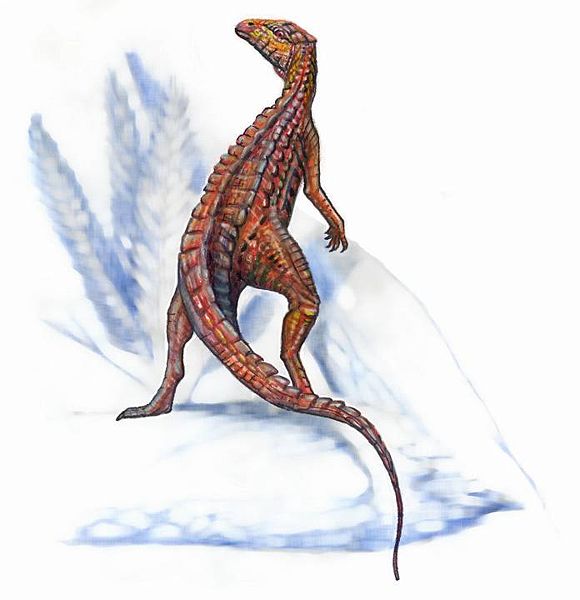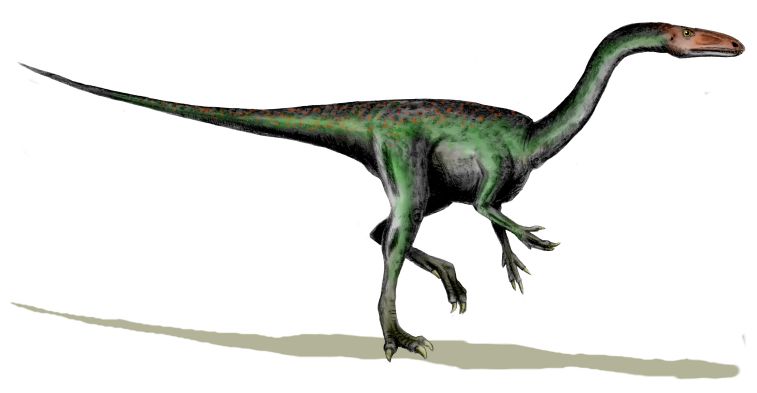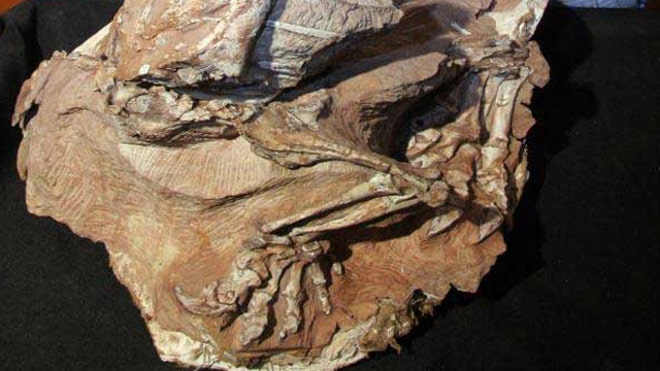[Recent Entries][Archive][Friends][User Info]
December 28th, 2012
| December 28th, 2012 | |
|---|---|
| 07:46 pm [industrialterro] [Link] |
Scutellosaurus Scutellosaurus (meaning "little-shielded lizard") is a genus of herbivorous dinosaur that lived in North America around 200 to 196 million years ago, in the Early Jurassic times. It is classified in Thyreophora, the armoured dinosaurs; its closest relatives may have been Emausaurus and Scelidosaurus, another armored dinosaur which was mainly a quadrupedal dinosaur, unlike bipedal Scutellosaurus. It is one of the earliest representatives of the armored dinosaurs and the basalmost form to date. Scutellosaurus was around 1.2 metres (3.9 ft) long, 50 centimetres (20 in) tall at the hips, and weighed 10 kilograms (22 lb). The fossil evidence includes two partial skeletons recovered from Arizona, although of the skull only the lower jaw has been recovered. There were also several hundred scutes running along its neck to its back and as far down as its tail. Some of these shields were flat, while others were pitted. It had an unusually long tail, possibly to provide a counterbalance against the weight of the armored body, and long arms that suggest it may have browsed on all fours. Скутеллозавр был описан в 1984 году профессором Эдвином X. Кольбертом. У растительноядного скутеллозавра имелись простые листовидные зубы, немного похожие на зубы современной растительноядной ящерицы игуаны. Скутеллозавр, очевидно, питался растительной пищей, также как и современные игуаны. Интересной особенностью этого динозавра являлось наличие плоских минищитков, проростающих из кожи динозавра. Фаброзавриды, единственным американским представителем которых был скутеллозавр, — это наиболее примитивные птицетазовые птиценогие динозавры с четырехлучевым тазом. У всех у них лобковая кость в тазу была направлена назад, а в пасти имелась предзубная кость, лишенная зубов и поддерживавшая роговой клюв. Фаброзавры по сравнению со всеми другими птицетазовыми динозаврами более всего напоминали ящериц. Однако у них не развились еще мускулистые защечные мешки, которые были у других птицетазовых динозавров — и помогали им удерживать растительную пищу в набитом рту. Из современных ящериц такие мешки есть у игуан. Фаброзавриды, вероятно, проводили жаркие летние месяцы в норах в спячке и выходили на поверхность только тогда, когда с началом влажного сезона возрождалась растительность.
Размеры тела в сравнении с человеком:
Tags: Вымершие рептилии, Юра, авеметатарзалии, архозавроморфы, архозавры, диапсиды, динозавроморфы, динозавры, птицетазовые, тиреофоры |
| Time | Event |
| 08:11 pm [industrialterro] [Link] |
Segisaurus Segisaurus (meaning "Segi canyon lizard") is a genus of small coelophysoid theropod dinosaur, that measured approximately 1 metre (3 feet) in length. The only known specimen was discovered in 1933 in early Jurassic strata in Tsegi Canyon, Arizona, for which it was named. Segisaurus is the only dinosaur to have ever been excavated from the area. It was later described in 1936 by the paleontologist Charles Lewis Camp. The fragmentary fossil skeleton consisted of portions of the limbs, pelvis, and vertebrae, but no cranial material was located. Segisaurus appears to have been closely related to the better-known Coelophysis. One distinction, however, was that Segisaurus had solid bones, while those of Coelophysis' were hollow. This even made some scientists consider if Segisaurus was even a theropod at all. Later investigations into the specimen in 2005 showed that Segisaurus did in fact have hollow bones, and lead scientists to believe that Segisaurus was related more closely to Procompsognathus. Segisaurus lived about 183 million years ago during the Jurassic period. Segisaurus was roughly the size of a goose and was a primitive bipedal theropod. Segisaurus was roughly 1 metre (3 feet) long, half a metre (1.5 feet) tall and weighed about 4-7 kilograms. It was nimble and insectivorous, although it may have scavenged meat also. It was bird-like in structure, with a flexible, elongated neck and stout body. Segisaurus was three-toed and had powerful legs that were long compared to its body length. Like its legs, Segisaurus had a long tail and long forearms. Its collar bone was not unlike a bird's, thus strengthening scientists' arguments that dinosaurs were related to avians. Segisaurus is described from the only specimen ever found. The holotype, however, was a sub-adult, so that the full size of Segisaurus as an adult may never be known. Strangely, clavicles were found on the Segisaurus specimen, which were unknown in other dinosaurs from that era. The first discovery of Segisaurus was by Max Littlesalt, a Navajo Indian who kept livestock inside Tsegi Canyon. After discovering the remains in the Navajo Sandstone formation of Arizona, Littlesalt pointed out the fossils to archeologists on an expedition inside the canyon. Other than the first finding of Segisaurus, no other specimens have been discovered. After its initial description by Charles Lewis Camp, the holotype went relatively ignored for the next half century. When the specimen was investigated during this period, all who viewed it commented on the presence of clavicles and the solid bone structures the dinosaur had. According to recent reports, Segisaurus is vital in understanding the evolution of early theropods. When the specimen of Segisaurus was discovered, Camp likened it to that of a "sitting hen", due to the position the dinosaur's remains were in. Other theropods used this positions to sleep or stay sheltered during sand and ash storms, and indeed the Segisaurus holotype was found in a bed of sand stone, suggesting that the dinosaur had been submerged in a layer of sand and died. This is still only a hypothesis, as no nest or den materials were discovered along the Segisaurus specimen. Another speculative interpretation from Camp has attracted less attention: that the "splint-like" neck ribs supported a Draco-like patagium along the neck, to improve the animal's ability to move quickly.
In September 2005, the Journal of Vertebrate Paleontology published a report which re-examined the remains of the Segisaurus holotype. The authors concluded, that although very unusual, Segisaurus was firmly a coelophysoid. They also noted that Segisaurus was probably a relative of Procompsognathus. Легкое и проворное животное (примерно 1-1,5 м длиной и 5 кг весом) с длинными задними лапами. Возможно, у него имелись ключицы, наподобие вилочковой кости у птиц. Шея довольно длинная. Долгое время этот вид выделяли в отдельное семейство Segisauridae, на том основании, что некоторые из его длинных костей не являются полыми (что для теропод, особенно мелких, является уникальным, ранее не встречавшимся фактом). Кроме того, в течение долгого времени, этот вид стоял особняком ввиду того, что был одним из немногих тероподов, у которых были найдены хорошо сохранившиеся ключицы. Кости бедра имеют необычные отверстия и неровности. Помимо этого, крайне необычно, что у практически полного посткраниального скелета отсутствовал череп.
Размеры тела в сравнении с человеком:
Tags: Вымершие рептилии, Юра, авеметатарзалии, архозавроморфы, архозавры, диапсиды, динозавроморфы, динозавры, тероподы, целофизиды, ящеротазовые |
| Time | Event |
| 08:42 pm [industrialterro] [Link] |
Seitaad Сейтаад (Seitaad) — род вымерших динозавров инфраотряда прозауропод, которые жили в период ранней юры (около 185 млн лет назад) на территории современного штата Юта (США). Вид Seitaad ruessi описан в 2010 году, на основе найденных ископаемых в пустыне Навахо в знаменитых Красных Скалах южной Юты. Ученые предполагают, что динозавр погиб, утонув в песчаных дюнах, которые существовали в штате Юта в течение раннего юрского периода. Свое название род сейтаад получил в честь мифического монстра племени навахо, а видовое имя ruessi было дано в честь исследователя и художника Эверетта Руэсса, который при невыясненных обстоятельствах таинственно исчез в возрасте 20 лет в 1934 году в том же регионе, где и были найдены останки динозавра. Пока что вид мало изучен, о нем известно совсем немного публикаций. Он является одним из первых зауроподоморфов Северной Америки, который имеет тесные родственные связи с ящерами Южной Америки. Взрослое животное достигало около метра в высоту, и имело от 3 до 4,5 метров в длину. Весил от 70 до 90 кг. Является одним из первых зауроподоморфом Северной Америки и имеет тесные связи с динозаврами из Южной Америки. Seitaad is known from an articulated partial postcranial holotype skeleton referred to as UMNH VP 18040. The skeleton is missing its head, neck and tail. It was collected from the Early Jurassic Navajo Sandstone, the uppermost unit of the Glen Canyon Group, dating to the Pliensbachian stage, near Comb Ridge, San Juan County. A phylogenetic study of Seitaad found it to be a plateosaur sauropodomorph, placing it in Massospondylidae or alternatively (a less probable position) in Plateosauridae, but its placement within the Plateosauria is not well understood. In a cladistic analysis, presented by Apaldetti and colleagues in November 2011, Seitaad was found to be within Massopoda, just outside Anchisauria. Seitaad was first described by Joseph J. W. Sertich and Mark A. Loewen in 2010 and the type species is Seitaad ruessi.
Размеры тела в сравнении с человеком:
Tags: Вымершие рептилии, Юра, авеметатарзалии, архозавроморфы, архозавры, диапсиды, динозавроморфы, динозавры, завроподоморфы, прозавроподы, ящеротазовые |
| Previous Day | 2012/12/28 [Archive] |
Next Day |

















